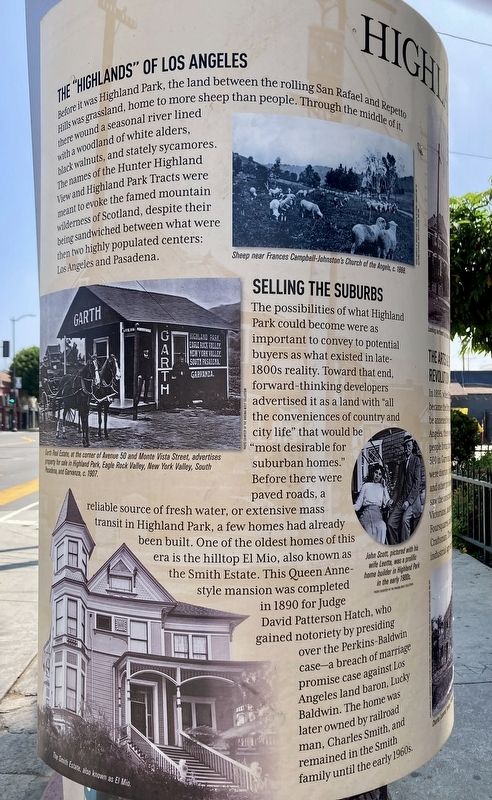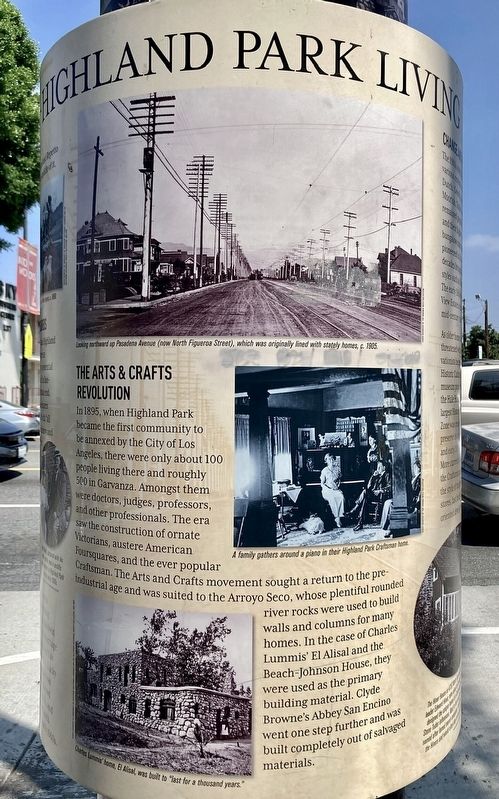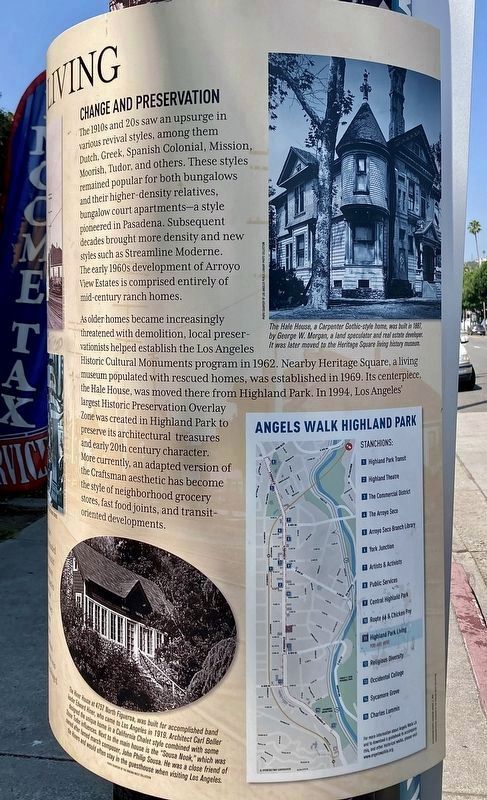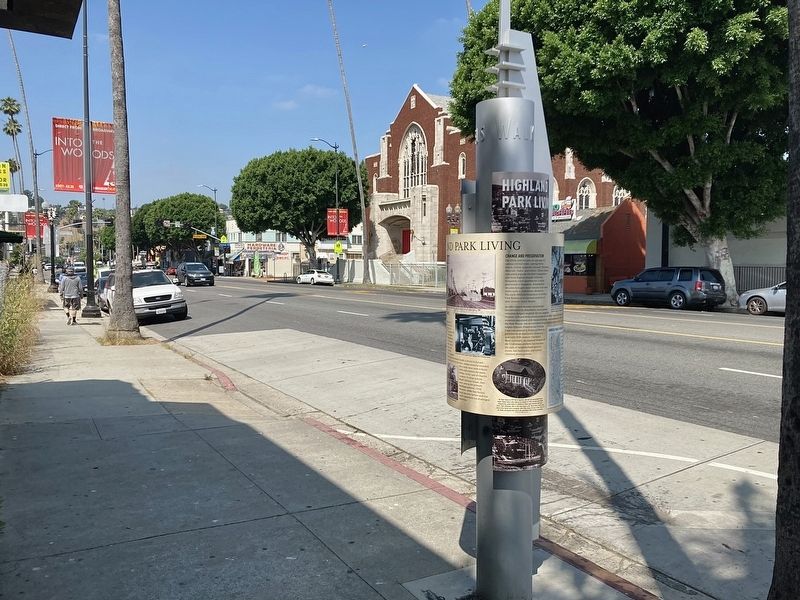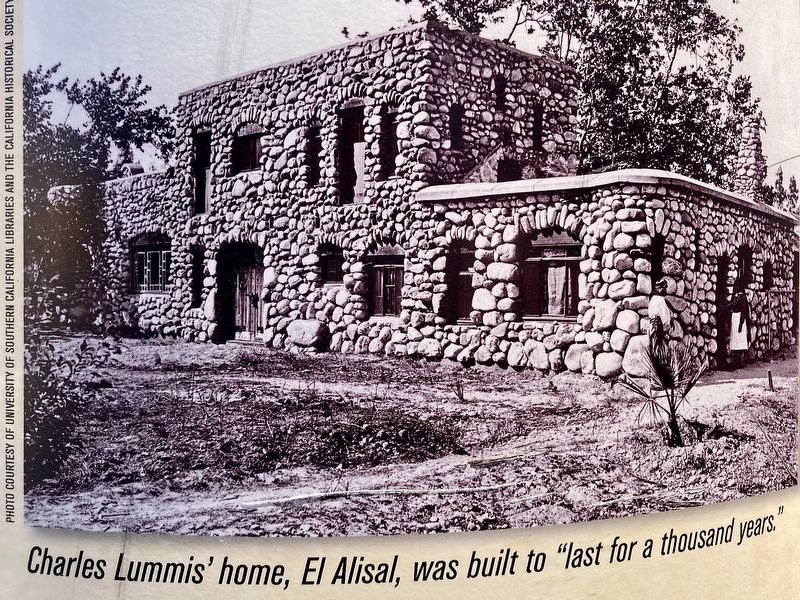Highland Park in Los Angeles in Los Angeles County, California — The American West (Pacific Coastal)
Highland Park Living
The "Highlands" of Los Angeles
Before it was Highland Park, the land between the rolling San Rafael and Repetto Hills was grassland, home to more sheep than people. Through the middle of it, there wound a seasonal river lined with a woodland of white alders, black walnuts, and stately sycamores. The names of the Hunter Highland View and Highland Park Tracts were meant to evoke the famed mountain wilderness of Scotland, despite their being sandwiched between what were then two highly populated centers: Los Angeles and Pasadena.
Selling the Suburbs
The possibilities of what Highland Park could become were as important to convey to potential buyers as what existed in late-1800s reality. Toward that end, forward-thinking developers advertised it as a land with "all the conveniences of country and city life" that would be "most desirable for suburban homes." Before there were paved roads, a reliable source of fresh water, or extensive mass transit in Highland Park, a few homes had already been built. One of the oldest homes of this era is the hilltop El Mio, also known as the Smith Estate. This Queen Anne-style mansion was completed in 1890 for Judge David Patterson Hatch, who gained notoriety by presiding over the Perkins-Baldwin case - a breach of marriage promise case against Los Angeles land baron, Lucky Baldwin. The home was later owned by railroad man, Charles Smith, and remained in the Smith family until the early 1960s.
The Arts & Crafts Revolution
In 1895, when Highland Park became the first community to be annexed by the City of Los Angeles, there were only about 100 people living there and roughly 500 in Garvanza. Amongst them were doctors, judges, professors, and other professionals. The era saw the construction of ornate Victorians, austere American Foursquares, and the ever popular Craftsman. The Arts and Crafts movement sought a return to the pre-industrial age and was suited to the Arroyo Seco, whose plentiful rounded river rocks were used to build walls and columns for many homes. In the case of Charles Lummis' El Alisal and the Beach-Johnson House, they were used as the primary building material. Clyde Browne's Abbey San Encino went one step further and was built completely out of salvaged materials.
Change and Preservation
The 1910s and 20s saw an upsurge in various revival styles, among them Dutch, Greek, Spanish Colonial, Mission, Moorish, Tudor, and others. These styles remained popular for both bungalows and their higher-density relatives, bungalow court apartments - a style pioneered in Pasadena. Subsequent decades brought more density and new styles such as Streamline Moderne. The early 1960s development of Arroyo View Estates is comprised entirely of mid-century ranch homes.
As older homes became increasingly threatened with demolition, local preservationists helped establish the Los Angeles Historic Cultural Monuments program in 1962. Nearby Heritage Square, a living museum populated with rescued homes, was established in 1969. Its centerpiece, the Hale House, was moved there from Highland Park. In 1994, Los Angeles’ largest Historic Preservation Overlay Zone was created in Highland Park to preserve its architectural treasures and early 20th century character. More currently, an adapted version of the Craftsman aesthetic has become the style of neighborhood grocery stores, fast food joints, and transit-oriented developments.
Erected 2017 by City of Los Angeles.
Topics. This historical marker is listed in these topic lists: Architecture • Settlements & Settlers.
Location. 34° 6.434′ N, 118° 11.843′ W. Marker is in Los Angeles, California, in Los Angeles County. It is in Highland Park. Marker is on Figueroa Street near Avenue 54, on the right when traveling north. Touch for map. Marker is at or near this postal address: 5330 N Figueroa St, Los Angeles CA 90042, United States of America. Touch for directions.
Other nearby markers. At least 8 other markers are within walking distance of this marker. Route 66 & Chicken Boy (approx. 0.2 miles away); Highland Theatre (approx. ¼ mile away); Smith House (approx. 0.3 miles away); Occidental College (approx. 0.3 miles away); Highland Park Ebell Club (approx. 0.3 miles away); Central Highland Park (approx. 0.3 miles away); Highland Park Transit (approx. 0.3 miles away); The Commercial District (approx. 0.3 miles away). Touch for a list and map of all markers in Los Angeles.
Also see . . . Angels Walk L.A. Self-guided walking tours of historic neighborhoods in Los Angeles. This marker is part of the Highland Park walk. (Submitted on July 20, 2023.)
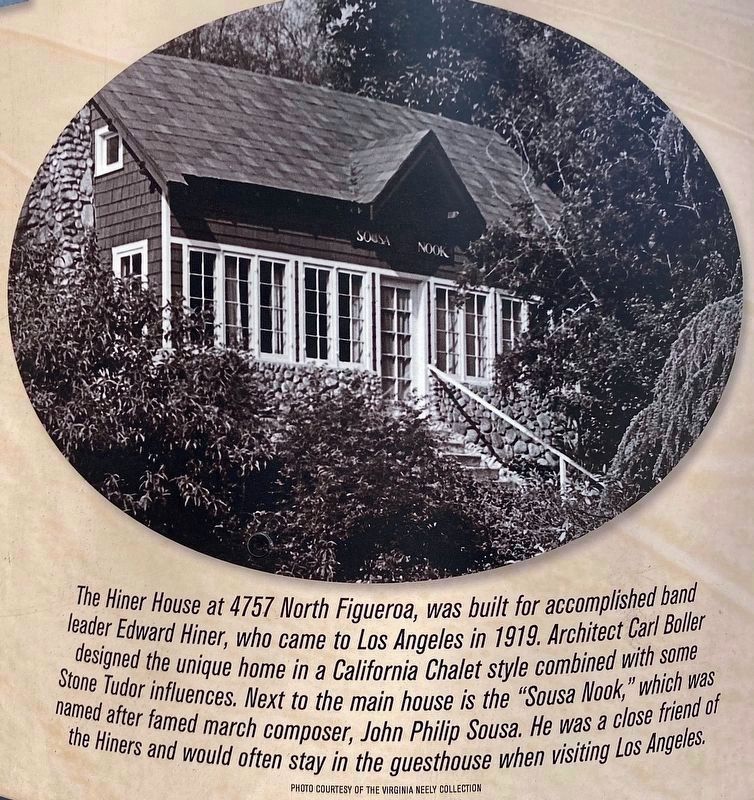
6. Sousa Nook
The Hiner House at 4757 North Figueroa was built for accomplished band leader Edward Hiner, who came to Los Angeles in 1919. Architect Carl Boller designed the unique home in a California Chalet style combined with some Stone Tudor influences. Next to the main house is the "Sousa Nook" which was named after famed march composer John Philip Sousa. He was a close friend of the Hiners and would often stay in the guesthouse when visiting Los Angeles.
Credits. This page was last revised on July 20, 2023. It was originally submitted on July 20, 2023, by Craig Baker of Sylmar, California. This page has been viewed 60 times since then and 20 times this year. Photos: 1, 2, 3, 4, 5, 6. submitted on July 20, 2023, by Craig Baker of Sylmar, California.
